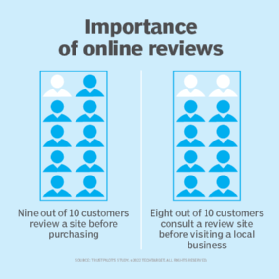
Getty Images
How much can a bad review hurt your business?
Companies may wonder how bad reviews can hurt their business. A few bad reviews are not necessarily harmful but can present ways to improve and highlight customer service.
Bad reviews can hurt a company, but how much a bad review hurts depends on how you handle it.
Customer experience sums up a person's feelings when interacting with a company. The customer experience begins pre-purchase when reading reviews and interacting with sales and marketing agents and continues post-purchase when troubleshooting and interacting with customer care.
When customers are unhappy, it changes the perception of a company. Ninety-seven percent of customers said that bad customer service changes buying behavior, according to a survey from Zendesk and Dimensional Research. And turning to a review site or social media, an unhappy customer can let others know about the bad experience with a company.
However, not all reviews are genuine. Fake reviews can bring a business or product rating down for no reason or try to lift another company above others. In July 2022, Amazon sued a group of Facebook administrators over fake reviews stating that admins solicited these reviews for money or free product to boost product and search rankings.
If you are a victim of fake or negative reviews, it can hurt your company's reputation, customer relations and earnings. However, bad reviews may not always have a negative effect if you provide solutions, show customers you care and learn from mistakes.
Here are some ways bad reviews can hurt your company.
Undermine reputation
When customers read bad reviews from other customers, it can cause them to lose trust and undermine the reputation of a business. Word of mouth is a powerful social and marketing tool, and online reviews have the same potential -- positive or negative.

Fifty percent of customers said they question the quality of a business if there are several negative reviews, according to BrightLocal's 2022 "Local Consumer Review Survey."
Drive customers away
If a customer takes the time to write a negative review, they are clearly upset. If your company doesn't respond to this review, you could lose the customer for good and lose potential customers in the meantime.
Nine out of 10 consumers use a review site before making a purchase at a business, according to review site Trustpilot's study. The same study also found that eight in 10 shoppers consult a review site -- such as Yelp or Google -- before visiting a local business.
Lower search engine ranking
Customers leaving bad reviews online is common, and a few bad reviews won't have much effect on a company's search engine ranking. However, if there are several bad reviews and they are more prominent, it leaves a bad impression to both potential customers and search engine results.
Google's SEO guidelines want to place quality businesses at the top of search results, so multiple negative reviews will drive down the rating.
Loss of revenue and profit
More customers driven away by bad reviews means less money coming in. Small businesses with a one to 1.5 star rating on Google earned 33% less than the average business, according to a study by Womply Research.
How to manage negative reviews
Don't be afraid of negative reviews. Think of these comments as an opportunity to showcase your customer service. Do not censor and remove negative remarks because 95% of customers are suspicious of a company with all positive reviews, according to Reevoo's e-book Bad reviews are good for business.
Respond to bad reviews quickly
Be sure to respond to negative reviews as soon as possible. It's best to respond to both negative and positive reviews because it can help establish trust with customers.
Apologies should be sincere. Acknowledge the person's experience and let them know you heard them and will address the issue. Avoid making excuses and thank the person for reaching out.
Customer experience can drive sales, and using customer feedback can help your business make the necessary changes to do even better. Customers want to know that you take their thoughts into consideration.
Offer to fix the problem
People who leave negative reviews usually want their problem fixed. Reach out to the customer and ask them to contact you directly to explain what happened. You want to get the conversation offline to speak more freely.
Listen to their concerns and offer them a solution, such as a refund, gift card or other freebie to get them to return and have a better experience. Let your staff know about the issue so they can make sure it doesn't happen again and create a plan for better customer service.
Use negative feedback to improve
Watch for any patterns or similarities if your company receives multiple negative reviews. For example, see if people are complaining about similar product features and then see how to update them.
For more customer service or overall management issues, use these reviews to determine if you need to change any areas -- such as office hours or response time -- or offer training and support to employees to improve the customer experience.
Learn more about must-have skills for customer service professionals.
Encourage reviews from other customers
Ask customers to give positive reviews to increase your overall rating. Create a strategy to solicit these reviews from your valued customers. Make it easy for customers to leave reviews, such as sending links in emails.
Use social media to solicit customer feedback. Initiate conversations that encourage interaction such as, "What is your favorite product from us?" or "How are you using the product?"
Monitor sites for reviews
Use online reputation management tools -- such as Brandwatch, Brand24 and Digimind -- to help manage online reviews. These tools will alert you to reviews and help you keep a positive online reputation.
If you don't have online tools, regularly monitor popular review sites such as Yelp, Google, Facebook or Better Business Bureau. And don't forget to check niche websites for your industry where customers may leave a review. Visit these websites periodically to search for comments.
Ask happy customers to update negative reviews
If the customer is satisfied with how you handled their negative experience, ask them to update their review. They don't have to take down their negative review unless they would like to, but it may benefit potential customers to see how your company handled the issue and made them happy.
Avoid and spot fake reviews
Fake reviews may seem like a good idea to add some positive comments about your business. However, do not post fake positive reviews to outweigh the negative ones. It's best to stay away from creating or responding to fake reviews. Customers are skeptical of all five-star rated businesses. Review sites will catch on to fake reviews and penalize companies for posting them.
Take the Competition and Markets Authority probe of Amazon and Google fake reviews, for example. They checked for possible breaches of consumer protection laws and to see if the companies adequately addressed these reviews on their sites.
Here are some red flags to watch out for when looking to see if a review is fake.
- Look for other reviews. You can search the user's profile on sites such as Yelp to see other reviews. Look to see if they are consistently negative or positive and if they are about one place or product. If the reviews are similar, they are probably fake.
- Check spelling and grammar. Make sure it sounds like the review came from a real person. While spelling and grammar are not always perfect, large amounts of low-quality spelling and grammar is a good indicator the review is false.
- Watch for black-and-white reasoning. Fake reviews always have black or white in their reasoning without many details. People don't always completely love or hate something. If the reviewer's other posts are all black and white, they are probably fake.
- Search for certain words. Fake product reviews tend to overuse the words "me" and "I" while using a lot more verbs. Look for more nouns and check that the review seems truthful.
- Check into the user. See if you have record of the person doing business with your company if they leave a full name. If you have no record of this person, it is probably fake.








